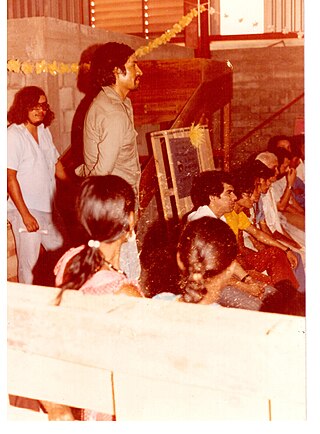The Chatinos are an indigenous people of Mexico. Chatino communities are located in the southeastern region of the state of Oaxaca in southern central Mexico. Their native Chatino language are spoken by about 23,000 people, but ethnic Chatinos may number many more. The Chatinos of San Juan Quiahije call themselves neq-a tnya-j and their language Chaq-f tnya-b.
Santa Catarina Juquila is a town in the State of Oaxaca, Mexico, and is the seat of the municipality also called Santa Catarina Juquila. It is part of the Juquila District in the center of the Costa Region. The name "Juquila" comes from "Xuhquililla", which means "Place of blue milkweed".
San Carlos Yautepec is a town and municipality in Oaxaca in south-western Mexico. It is part of the Yautepec District in the east of the Sierra Sur Region. The name "Yautepec" means "hill of black corn".
San Juan Guichicovi is a town and municipality in Oaxaca in south-western Mexico. It is part of the Juchitán District in the west of the Istmo de Tehuantepec region. The town was founded on 15 March 1825: Guichicovi means "New Town" in Zapotec.

San Juan Juquila Mixes is a town and municipality in Oaxaca in south-western Mexico. It is part of the Yautepec District in the east of the Sierra Sur Region. The name "Juquila" means "beautiful vegetables".
San Juan Mazatlán is a town and municipality in Oaxaca in south-western Mexico. It is part of the Sierra Mixe district within the Sierra Norte de Oaxaca Region. Mazatlán's name in Nahuatl means "the place of deer".
San Juan Quiahije is a town and municipality in Oaxaca in south-western Mexico. It is part of the Juquila District in the centre of the Costa Region. The origen of Quiahije is not known, some people conjecture it might mean "Stone Forest" in the Zapotec language.
San Miguel Panixtlahuaca is a town and municipality in Oaxaca in south-western Mexico. It is part of the Juquila District in the center of the Costa Region. The name "Panixtlahuatl" in the Nahuatl language means "Plain of the Bridge".
San Miguel Quetzaltepec is a town and municipality in Oaxaca in south-western Mexico. It is part of the Sierra Mixe district within the Sierra Norte de Oaxaca Region. The name "Quetzaltepec" means "hill of the quetzal", a tiny bird with a large red and green tail that is now rare in the area.
Tataltepec de Valdés is a town and municipality in Oaxaca in south-western Mexico. It is part of the Juquila District in the center of the Costa Region. The town was established around 400-300 BC. The name "Tataltepec" means "Grandfather hill". Antonio Valdés, born in the town, was an early leader of the independence movement in Oaxaca who died on 19 November 1811.
Santa Cruz Zenzontepec is a town and municipality in Oaxaca in south-western Mexico. It is part of the Sola de Vega District in the Sierra Sur Region.
Santa María Alotepec is a town and municipality in Oaxaca in south-western Mexico. It is part of the Sierra Mixe district within the Sierra Norte de Oaxaca region.
Santa María Temaxcaltepec is a town and municipality in Oaxaca in south-western Mexico. It is part of the Juquila District in the center of the Costa Region.
Santiago Atitlán is a town and municipality in Oaxaca in south-western Mexico. It is part of the Sierra Mixe district within the Sierra Norte de Oaxaca Region.
Santiago Ixcuintepec is a town and municipality in Oaxaca in south-western Mexico. It is part of the Sierra Mixe district within the Sierra Norte de Oaxaca Region.
Santiago Yaitepec is a town and municipality in Oaxaca in south-western Mexico, two kilometers southeast of Santa Catarina Juquila. It is part of the Juquila District in the center of the Costa Region. The name "Yaitepec" means "Three hills".

Juquila District is located in the center of the Costa Region of the State of Oaxaca, Mexico, on the Pacific coast. It has an area of 5,055 km2. As of 2005 it had a total population of 134,365 of whom 33,106 spoke an indigenous language. Economic activities include agriculture and tourism. The Santuario (Sanctuary) de Juquila is a major attraction.

The Union of Indigenous Communities of the Isthmus Region, is a farmer's cooperative in the state of Oaxaca, Mexico. It was established in 1982 to assist in production, marketing and distribution of locally produced coffee and other products. UCIRI was a pioneer of organic coffee production and one of the first fair trade suppliers.

The Indigenous people of Oaxaca are descendants of the inhabitants of what is now the state of Oaxaca, Mexico who were present before the Spanish invasion. Several cultures flourished in the ancient region of Oaxaca from as far back as 2000 BC, of whom the Zapotecs and Mixtecs were perhaps the most advanced, with complex social organization and sophisticated arts.

Tomás Cruz Lorenzo was a Chatino activist and writer from San Juan Quiahije San Juan Quiahije , Oaxaca, Mexico. He belonged to a generation of communalist, indigenous thinkers in Mexico which included Floriberto Díaz and Jaime Martínez Luna. His writings are influenced by anarchist ideas and call for the defense of the Chatino language and culture and for the autonomy of the Chatino land, which extends from the coast to the highlands of the Sierra in southeast Oaxaca. He was assassinated while waiting for a bus in 1989. The murder remains unsolved.
This town celebration is from January 19,20,21 y 22. Celebration of Dulce señor Jesus. The tradicional dance of the celebration is called baile del huajolote.





